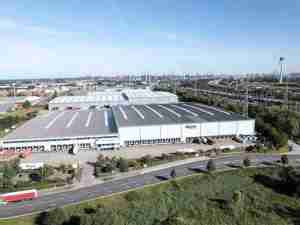The giant ocean-going vessel with a length of 366 meters and a bread of 55 meters was given a commensurate welcome by representatives of the Port of Hamburg: Werner Viessmann, Head of habor master’s division and Bernd Ahlf, Director of Finances for Port of Hamburg Marketing, who presented Anatoliy Borodulin, Captain of the Hong Kong-flag ship with a Hamburg Admiralty plaque. The “CSCL Mars” had sailed on her maiden voyage in the joint Asia Europe Express Service 7 (AEX 7) run by the China Shipping Container Lines and Evergreen shipping lines from Shanghai at the end of October. She continued from there to the ports of Ningbo and Shekou and then on to Hong Kong, Yantian and Port Kelang. The “CSCL Mars” then passed through the Suez Canal and made two stops in ports in Western Europe before berthing at Eurogate Container Terminal in the Port of Hamburg on the afternoon of 7 December.
The increased deployment of larger ships on liner services between Asia and Hamburg is evidence of further growing container traffic between the two regions. In the first nine months of this year traffic with Asia attained a volume of over 3.9 million TEU and was accordingly up by 10.6 percent by comparison with last year. China continues to occupy No. 1 spot in the ranking of Hamburg’s top trading partners for container handling and this is another still growing link. At the end of the first nine months of 2011, around 2.3 million TEU had already been transported between Hamburg and China by sea, representing growth of 11.7 percent. The intensive cargo flows between Hamburg and East Asia are currently catered for by 27 liner services.
Built at the Samsung shipyard in Koje, South Korea, with a capacity of 14,000 TEU the “CSCL Mars” is among the largest of over 140 vessels in China Shipping’s fleet. At a press conference to mark a call by her sistership “CSCL Star”, China Shipping’s Vice President Hangzhou Zhao did not exclude the possibility that in future even larger vessels could play a role for China Shipping.
The Port of Hamburg also needs to be prepared for calls by larger ships. The European Commission has in the course of the planning process expressed itself in favour of the adjustment of the Elbe navigation channel. “We are delighted that the European Commission has given the green light. We are reckoning on the neighbouring states of Schleswig-Holstein and Lower Saxony also reacting favourably and agreeing. The adjustment of the navigation channel is indispensable for both the infrastructure and the economy of North Germany. The Port of Hamburg powers jobs in the region, making it a leading employer,” said Claudia Roller, Port of Hamburg Marketing’s CEO in emphasizing the urgency of the work. In Berlin and Hamburg it is being assumed that the necessary planning consent can be granted in spring 2012.









